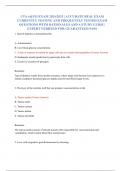UTA A&P II EXAM 2024/2025 | ACCURATE REAL EXAM
CURRENTLY TESTING AND FREQUENTLY TESTED EXAM
QUESTIONS WITH RATIONALES AND A STUDY GUIDE |
EXPERT VERIFIED FOR GUARANTEED PASS
1. Type II diabetes is characterized by:
A. Autoimmunity
B. Low blood-glucose concentration
C. A lack of response to insulin by target cells due to receptor downregulation (Correct Answer)
D. Inadequate insulin production by pancreatic beta cells
E. Excessive secretion of glucagon
Rationale:
Type II diabetes results from insulin resistance, where target cells become less responsive to
insulin, leading to decreased glucose uptake and elevated blood sugar levels.
2. The layer of the arteriole wall that can produce vasoconstriction is the:
A. Tunica media (Correct Answer)
B. Tunica mater
C. Tunica externa
D. Tunica intima
E. Tunica adventitia
Rationale:
The tunica media consists of smooth muscle cells responsible for vasoconstriction and
vasodilation, which control blood flow and pressure.
3. Liver cells respond to growth hormones by releasing:
,A. Glucocorticoids
B. Gonadotropins
C. Insulin-like growth factors (Correct Answer)
D. Prostaglandins
E. Hepatic hormones
Rationale:
Growth hormone stimulates the liver to release insulin-like growth factors (IGFs), which
promote cell growth and development.
4. The pituitary hormone that stimulates milk production by the mammary glands is:
A. Prolactin (Correct Answer)
B. TSH
C. Oxytocin
D. Growth hormone
E. FSH
Rationale:
Prolactin is secreted by the anterior pituitary gland and is responsible for stimulating milk
production in the mammary glands.
5. The following is a list of vessels and structures associated with the heart. What is the correct
order for the flow of blood entering from the pulmonary circulation?
Blood enters RA
LA
RV
,LV
Vena Cava
Aorta
Pulmonary Trunk
Pulmonary Veins
A. 5, 1, 3, 8, 7, 2, 4, 6
B. 5, 3, 1, 7, 8, 4, 2, 6
C. 1, 2, 7, 8, 3, 4, 6, 5
D. 1, 7, 3, 8, 2, 4, 6, 5
E. 8, 2, 4, 6, 5, 1, 3, 7 (Correct Answer)
Rationale:
The pulmonary veins bring oxygenated blood from the lungs into the left atrium (LA), then flow
through the left ventricle (LV), aorta, and systemic circulation.
6. A rise in angiotensin II levels would result in all of the following EXCEPT:
A. Increased blood volume
B. Increased urine production (Correct Answer)
C. Elevated blood pressure
D. Increased retention of sodium at the kidney
E. Increased water retention
Rationale:
Angiotensin II increases blood pressure by causing vasoconstriction and promoting sodium and
water retention, but it decreases urine production to conserve fluid.
7. Type II alveolar cells produce:
, A. Surfactant (Correct Answer)
B. Mucus
C. Histamine
D. Pleural fluid
E. Carbonic anhydrase
Rationale:
Type II alveolar cells secrete surfactant, which reduces surface tension in the lungs, preventing
alveolar collapse and making breathing easier.
8. The pulmonary veins carry ____ blood to the ____:
A. Deoxygenated; left atrium
B. Oxygenated; left atrium (Correct Answer)
C. Oxygenated; right lung
D. Deoxygenated; right atrium
E. Deoxygenated; superior vena cava
Rationale:
The pulmonary veins transport oxygen-rich blood from the lungs to the left atrium for systemic
circulation.
9. Erythropoiesis is stimulated when:
A. Oxygen levels in the blood decrease (Correct Answer)
B. Oxygen levels in the blood increase
C. Blood flow to the liver declines
D. A and C
E. B and C




